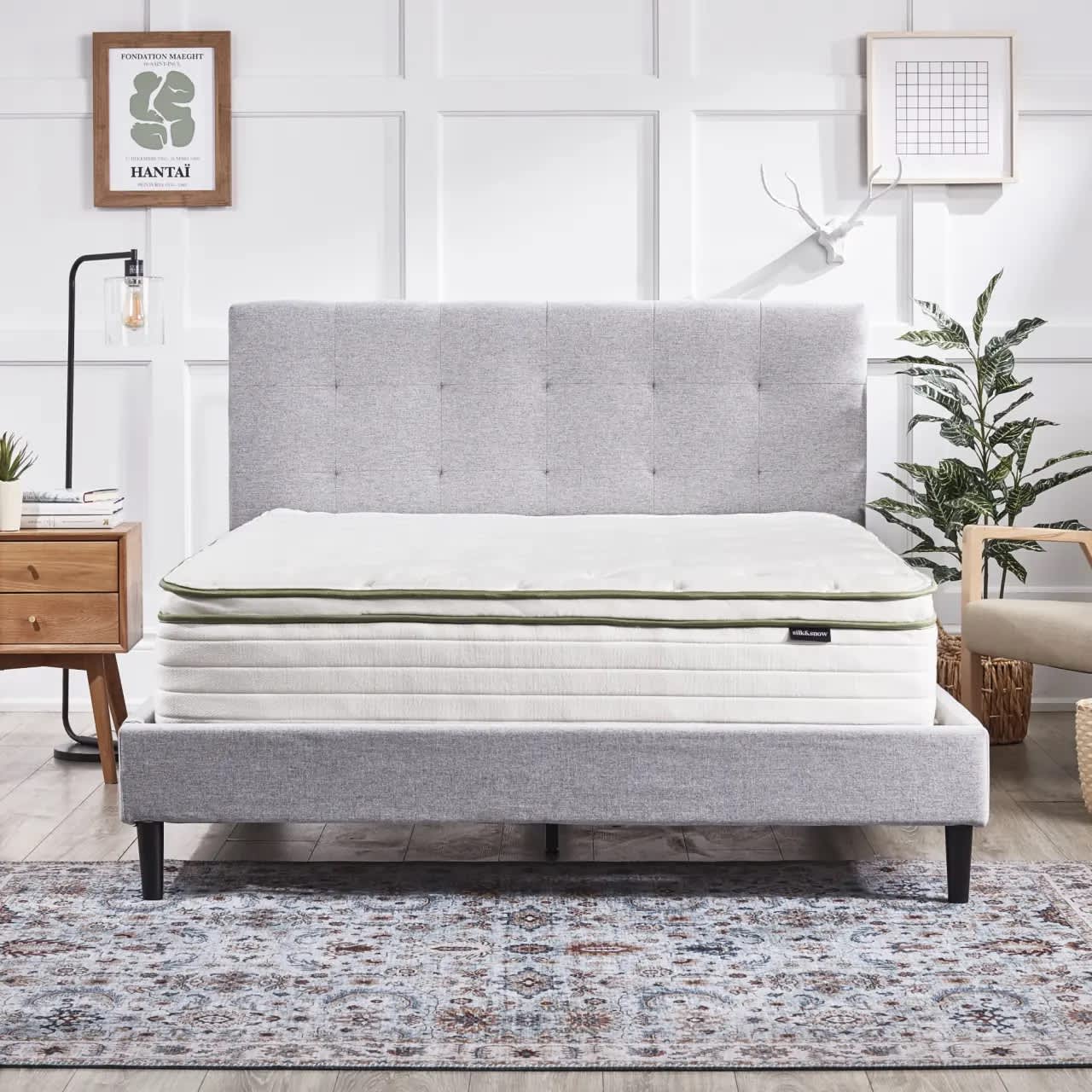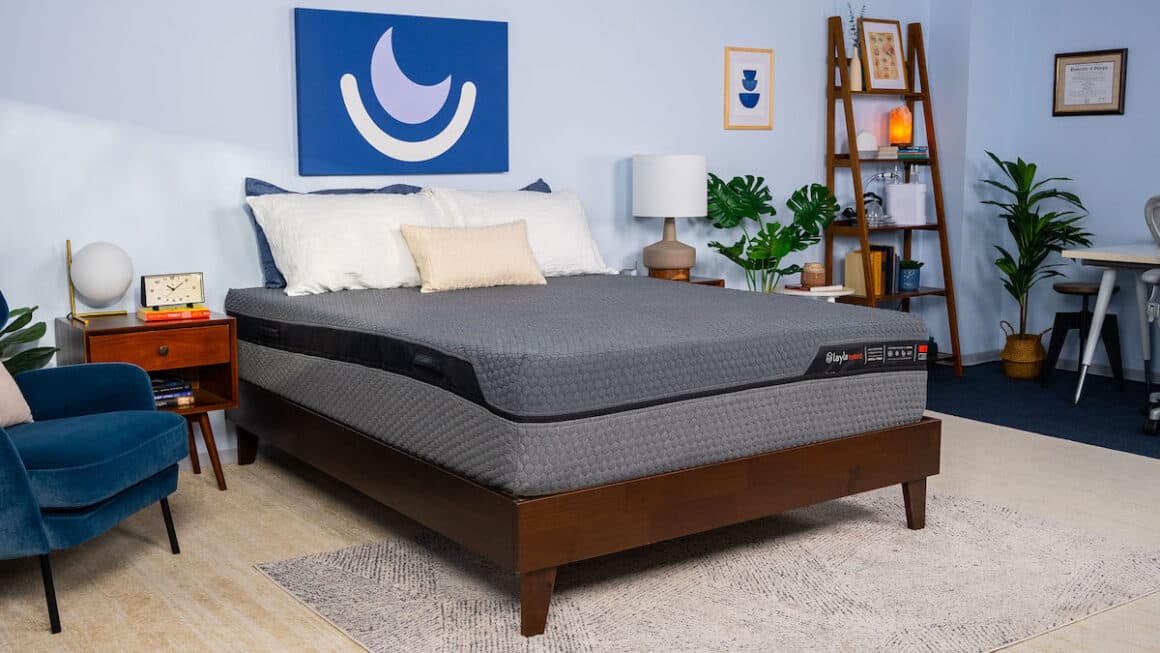On This Page
The Best Mattress for Pregnancy
Our Top Picks
-
Best Overall Mattress
Saatva Classic -
Best Value Mattress
Silk & Snow Organic -
Most Comfortable Mattress
Layla Hybrid -
Best Luxury Mattress
DreamCloud Premier Hybrid -
Best Mattress for Back Pain
WinkBed -
Best Cooling Mattress
Birch Mattress
Best Overall Mattress

The Saatva Classic provided our testers versatile comfort and impressive support across most body types and sleep positions. The bed’s design is durable and offers a good mixture of features for pregnant sleepers, including a cool feel, above-average pressure relief, and a slight bounce that makes it easy to change positions.
Pros & Cons
Pros
- Options for different thickness and firmness levels to suit every body type
- Breathable dual-coil design facilitates movement and limits heat retention
- Lumbar support caters to pregnancy-related back pain
Cons
- Average motion isolation means tossing and turning could affect your partner
- Slightly higher-than-average price tag
- Firmer model provides limited pressure relief for side sleeping
Ratings
Our Take
Best Value Mattress

Premium materials at a reasonable price make the Silk & Snow Organic a great buy for value seekers. This bed’s natural comfort layers and medium firm (6) feel work well for side sleepers of all weights. A reinforced coil support core also adds breathability and easy movement.
Pros & Cons
Pros
- Certified organic materials reduce exposure to harmful chemicals
- Strong edge support makes getting in and out of bed easy
- Zoned coil system provides targeted support to help with aches and pains
Cons
- Different firmness options come at an added cost
- Moderate pressure relief may lead to pressure buildup in the hips
- Responsive latex and coil design leads to below-average motion isolation
Ratings
Our Take
Most Comfortable Mattress

The Layla Hybrid is a flippable mattress with a medium soft (4) side and a firm (7) side that can accommodate a pregnant sleeper’s changing needs. A pocketed coil core with a reinforced perimeter facilitates movement while allowing sleepers to sit or sleep along the edge.
Pros & Cons
Pros
- Flippable design with two firmness levels that cater to changing needs
- Strong edge support makes it easy to get out of bed
- Thick foam layers on soft side provide hug-like pressure relief
Cons
- The mattress is heavy, so pregnant people shouldn’t help flip it without their doctor’s approval
- Firm side may not offer sufficient pressure relief for pregnant sleepers
- May be harder to change positions on the plush side
Ratings
Our Take
Best Luxury Mattress
The DreamCloud Premier Rest is a hybrid bed with a complex, luxury design. The bed’s four-layer comfort system offers impressive pressure relief for side sleepers while staying cool. This hybrid is also incredibly quiet and stifles motion for couples.
Pros & Cons
Pros
- Outstanding cushioning and support for pregnant side sleepers
- Conforms closely without trapping much heat
- Little to no noise and better-than-average motion isolation for a hybrid
Cons
- Softer edges can be a challenge for mobility changes in late pregnancy
- High-profile design requires deep pocket sheets
- Complex construction comes with a higher price tag
Ratings
Our Take
Best Mattress for Back Pain

The WinkBed is a modern innerspring mattress. With four firmness levels to choose from, almost any sleeper can find a model that meets their needs. Zoned support helps bolster the lumbar area to reduce midsection sinkage that could otherwise contribute to back pain.
Pros & Cons
Pros
- Four firmness options to accommodate different sleepers
- Zoned pocketed coils support the lower back
- Durable design with great edge support
Cons
- Average pressure relief
- Softer model could slightly impede movement
- Firmer options may transfer some vibrations
Ratings
Our Take
Best Cooling Mattress

The Birch Mattress is a hybrid bed made with premium, mostly natural materials. The surface stays noticeably cool thanks to breathable layers of wool, natural Talalay latex, and pocketed coils.
Pros & Cons
Pros
- Responsive layers facilitate movement
- Organic layers of wool and latex combined with coil core sleep cool
- Little to no off-gassing
Cons
- Responsive layers transfer moderate movement
- Minimal hug may not appeal to sleepers who like memory foam
- May feel too firm for side sleepers under 130 pounds
Ratings
Our Take
Compare Our Top Picks
| Mattress | Mattress Type | Ideal For | Value | Sleep Trial |
| Saatva Classic | Innerspring | Back Sleepers | Fair Value | 365 Nights ($99 Return Fee) |
| Silk & Snow Organic | Hybrid | Back and Stomach Sleepers | Great Value | 365 nights (30-night requirement) |
| Layla Hybrid | Hybrid | Side Sleepers Of Any Weight | Great Value | 120 nights |
| DreamCloud Premier Hybrid | Hybrid | Back Sleepers | Great Value | 365 nights (30-night requirement) |
| WinkBed | Innerspring | Side Sleepers | Good Value | 120 nights (30 night requirement) |
| Birch Mattress | Hybrid | People With Back Pain | Good Value | 100 nights (30-night requirement) |
How Does Pregnancy Affect Your Sleep?
As your body grows and transforms during pregnancy, so do your sleep needs and patterns.
| Trimester | Common Symptoms |
| First | At the beginning of a pregnancy, you might find yourself overwhelmingly tired as your body works overtime. While some people sleep well in the first trimester, discomfort from nausea, tender breasts, headaches, heartburn, and frequent bathroom trips can make it harder to get a restful night. |
| Second | Just when you start to feel a bit more like yourself, finding a comfortable position becomes a nightly challenge. In the second trimester, back and leg pains may intrude on your sleep, alongside swollen ankles and fingers. |
| Third | The third trimester brings its own set of sleep disruptions: frequent bathroom visits, heartburn, labored breathing, and the physical challenge of finding a comfortable sleep position due to your growing baby bump. Anxiety about the upcoming arrival can also impact sleep quality. |
What Should You Consider in a Mattress for Pregnancy?
Choosing the right mattress during pregnancy is about optimizing comfort and support. The right mattress should enhance your sleep quality, offering relief from the discomforts associated with pregnancy and accommodating your body’s changing needs.
Mobility
When pregnant, changing positions or getting in and out of bed can become a surprisingly challenging task. A mattress with good edge support and ease of movement can make a world of difference, especially in the later stages of pregnancy. If you share the bed with a partner or pet, consider a mattress that minimizes motion transfer so both you and your partner enjoy undisturbed sleep.
Pain Relief
A good mattress provides strong pressure relief to areas prone to pain when sleeping during pregnancy, especially the back, hips, and shoulders. Materials like memory foam and latex conform to the body’s shape, offering targeted relief where it’s needed most. It’s also important to find a supportive mattress to prevent back pain as your baby grows.
Breathability
Some people run warm during pregnancy, so a mattress that effectively regulates temperature can help you stay cool and comfortable through the night. Naturally breathable mattress types include hybrids and latex models, while other materials may be enhanced with cooling gels, phase change materials, or ventilated and open-cell designs.
Off-Gassing
Off-gassing refers to the release of volatile organic compounds (VOCs) from new foam mattresses. These compounds are created when a mattress is manufactured and can create an unpleasant smell when mattresses are initially unwrapped from their packaging. Many pregnant people find they are especially sensitive to smell, so opt for a mattress made with natural materials or one with low VOC emissions that is certified by organizations like CertiPUR-US.
Price, Sleep Trial, and Warranty
Pregnancy comes with its own set of expenses, but being thoughtful about price, trials, and warranties can help your money go further. A queen-sized mattress typically ranges from $1,100 to $2,200. Sleep trials allow you to test a mattress at home with the option to return it if it doesn’t meet your needs. Warranties protect your investment, covering defects for a specified period and providing added reassurance during a time of significant change.
What Is the Best Mattress Type for Pregnancy?
The material from which a mattress is constructed significantly influences its performance, affecting everything from support and comfort to temperature regulation. When selecting the best mattress type for pregnancy, consider how each material caters to the changing demands of your body.
| Mattress Type | Pros | Cons |
| Foam | Foam mattresses shine in their ability to provide excellent pressure relief and motion isolation, both perks during pregnancy. | Close-conforming foams may retain heat, which could feel uncomfortable for some pregnant sleepers. Foam mattresses may lack support for people over 230 pounds. |
| Hybrid and Innerspring | Thanks to their coil core, hybrids and innersprings balance support and breathability. Their enhanced responsiveness is helpful for getting in and out of bed. | Many hybrids and innersprings don’t provide the plush comfort some expectant people desire, and motion transfer is higher in innerspring models. |
| Latex | Latex beds are highly responsive, durable, and breathable. Natural latex models are also eco-friendly and have a much lower potential for off-gassing compared with a synthetic foam mattress. | Many latex mattresses are luxury beds with corresponding price tags. This can be a barrier considering all of the purchases needed during a pregnancy. |
| Airbed | Airbeds allow you to adjust the mattress’ firmness as pregnancy progresses. Full-size and larger airbeds often allow sleeping partners to choose a different firmness on each side of the bed. | Like natural latex models, airbeds are generally expensive. Additionally, some pregnant people find it difficult to pinpoint the right firmness level, adding another source of frustration during restless nights. |
| Adjustable | Adjustable beds provide flexibility in your sleep positioning, reducing discomfort by allowing you to elevate parts of the mattress. This may be helpful for pregnant people experiencing swollen ankles or back pain. | In addition to a higher cost for the adjustable bed frame, not all mattresses are compatible. |
Video: Breaking Down Common Mattress Types
Watch our video to learn more about the similarities and differences between some of the major types of mattresses available.
How to Choose the Right Mattress Firmness for Pregnancy
The best mattress firmness for pregnancy varies based on your sleeping position, body weight, and personal preferences. Our suggestions focus on side sleepers, as doctors recommend left side sleeping during pregnancy to promote optimal blood flow and minimize pressure on the internal organs.
Our testing team suggests that most pregnant side sleepers look for a medium to medium firm mattress to accommodate changes in body weight and shape. Our 10-point firmness scale, which assigns lower numbers to soft mattresses and higher numbers to firm mattresses, can help you find the level of support and comfort that’s tailored to your needs.
Tips for Sleeping More Comfortably During Pregnancy
Sleeping during pregnancy can be challenging. We’ll offer practical tips and accessories to help you sleep better while pregnant.
Bedding Accessories for Pregnancy
Body and pregnancy pillows, mattress toppers, and adjustable bed bases can all help make your bed more comfortable during pregnancy. Pillows support the stomach and fit between the knees or under the lower back to reduce back strain, while mattress toppers can adjust the bed’s firmness level. An adjustable bed base allows for easy changes in sleeping position, which may be particularly helpful as pregnancy progresses.
Practice Healthy Sleep Hygiene
Maintaining healthy sleep hygiene can help you improve sleep during pregnancy. Experts recommend establishing a consistent sleep schedule, taking brief naps during the day, and adjusting your nighttime eating habits to avoid heartburn. Incorporating light exercise and relaxation techniques can also promote better sleep.
Sleep on Your Left Side
Sleeping on your left side is strongly recommended during pregnancy. This position improves circulation and blood flow to your baby, kidneys, and uterus. Utilizing body pillows can make side sleeping more comfortable, providing support and reducing pressure on your back and hips.
As long as you have a supportive mattress and pillow you’re less likely to experience back and neck pain while sleeping on your side.
Talk With Your Doctor
If you experience persistent sleep challenges during pregnancy, it’s important to check in with your doctor. They can offer personalized advice and address any potential underlying conditions, ensuring both your and your baby’s health and well-being.
Discover More Mattress Solutions
Looking to fine-tune your choices? We have a wealth of mattress guides to help you find the best mattress for your individual sleep style.
More Mattress Guides
How We Test
Our team at Sleep Doctor brings years of expertise and dedication to helping you find the right mattress for your pregnancy. When considering pregnancy and sleep, we examined a wide range of mattresses with pregnant sleepers in mind, rigorously testing every model for performance factors like pressure relief, edge support, and temperature regulation.
Discover more about our meticulous process on our methodology page, where we detail our testing and commitment to helping you find your perfect mattress.
Frequently Asked Questions
Most people agree that the best mattress for pregnancy offers a blend of pressure relief, support, ease of movement, and breathability. We recommend materials that provide gentle contouring and consistent support, like medium firm memory foam or hybrid mattresses.
Whether to choose a soft or firm mattress during pregnancy depends on your sleep position, body weight, and personal preferences. For most people, a medium to medium firm model can help support spinal alignment while also cushioning pressure points.
Side sleeping, especially on your left side, is widely regarded as the best sleeping position during pregnancy. This position keeps the weight of the baby off a primary vein, in turn facilitating blood flow to the fetus and your major organs.
To improve your sleep during pregnancy, maintain a regular sleep schedule, reduce caffeine intake, and try not to have big meals before bed. Build a relaxing nighttime routine that includes calming activities, like reading, listening to soft music, or taking a warm bath. If you’re still having trouble sleeping well, talk to your doctor.
